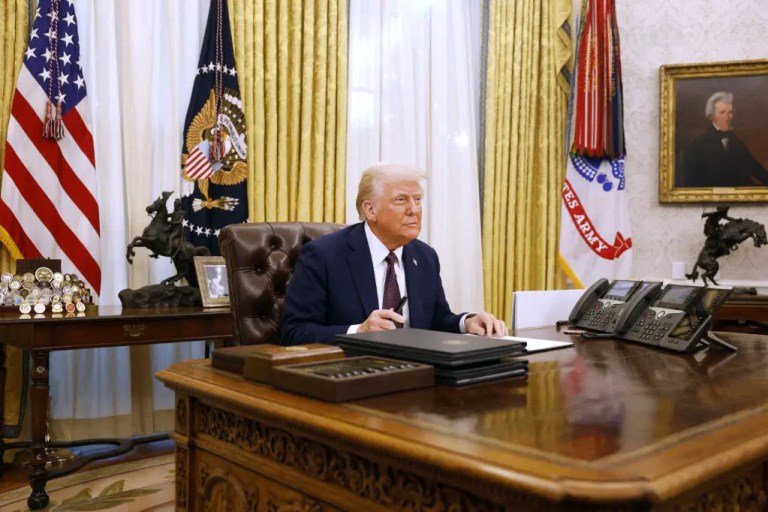Trump’s long-anticipated tariffs against Canada, Mexico, and China took effect today, igniting global economic unease and triggering retaliatory measures from America’s closest trading partners.
With 25% duties imposed on imports from Canada and Mexico, 10% for Canadian energy and 20% tariff on Chinese goods, the U.S. has thrust itself into a high-stakes trade war.
Promising prosperity, Trump touts tariffs as a “powerful weapon” to tackle trade deficits and border issues, defying warnings of inflation, GDP contraction, and job losses from experts.
The specter of a recession looms by mid-2025, driven by trade disruption s, supply chain breakdowns, and shaken confidence in the markets.
Here are the various factors that may drive the U.S. to recession as result of its ongoing trade war.
Trade Disruptions
Canada, Mexico, and China are the United States’ top trading partners, collectively accounting for over 40% of U.S. goods imports in recent years.
In 2023, U.S. imports from these countries exceeded $1.3 trillion, with Canada and Mexico alone representing highly integrated supply chains under the United States-Mexico-Canada Agreement (USMCA). The imposition of a 25% tariff on Canadian and Mexican goods and a 20% tariff on Chinese imports significantly increases the cost of these imports, disrupting trade flows.
Tax Foundation, estimates that a 25% tariff on Canada and Mexico could reduce U.S. GDP by 0.2% to 0.3% in the long run, even before retaliation.
The additional 20% tariff on China could shrink GDP by another 0.1% to 0.2%. Combined, these effects could total a 0.5% GDP reduction, a significant hit given that U.S. GDP growth has averaged around 2% annually in recent years. A sustained reduction of this magnitude could push the economy toward contraction, especially if amplified by other factors.
Industries like automotive manufacturing, which rely on parts crossing North American borders multiple times, face compounded costs.
For example, a Chevy Silverado’s production involves components crossing the U.S.-Mexico border several times; a 25% tariff at each crossing could increase final vehicle costs by thousands of dollars, reducing demand and production output. Similarly, the 20% tariff on Chinese electronics and machinery raises costs for U.S. manufacturers dependent on these inputs, further dampening industrial activity.
Inflationary Pressures
Tariffs are taxes on imports paid by U.S. importers, who typically pass these costs onto consumers and businesses. Historical evidence from Trump’s first-term tariffs (e.g., 25% on steel in 2018) shows that U.S. consumers bore most of the burden via higher prices, not foreign exporters.
The 25% tariffs on Canada and Mexico could raise prices for key goods like Mexican avocados (90% of U.S. supply), Canadian lumber (vital for housing), and vehicles (e.g., $69 billion in Mexican car imports in 2023).
Analysts at Jefferies estimate that these tariffs, combined with China’s, could add $2,700 to the average U.S. vehicle price.
The Peterson Institute for International Economics also suggests a middle-income household could lose $1,700 to $3,900 annually due to higher costs across goods.
Capital Economics predicts a 1 percentage point increase in U.S. inflation, pushing it toward 4% annually, double the Federal Reserve’s 2% target.
This stagflationary shock (higher prices with stagnant growth) erodes purchasing power, reducing consumer spending, which drives roughly 70% of U.S. GDP.
A sustained inflation surge could force the Federal Reserve to maintain or raise interest rates, further cooling economic activity and risking recession.
Retaliatory Tariffs and Export Losses
Canada, Mexico, and China have already signaled retaliation, mirroring patterns from Trump’s first term when China hit U.S. farm exports with tariffs and Canada and Mexico targeted U.S. goods like steel and agricultural products.
- Canada’s Response: Prime Minister Justin Trudeau’s plan to impose tariffs on over $100 billion of U.S. goods (announced March 4, 2025) targets key exports like Ohio’s $5 billion in auto parts and Maine’s $320 million in lumber. Canada, absorbing 75% of U.S. exports in some sectors, is a critical market; retaliation could cost U.S. exporters billions, slashing jobs in states like Texas (5% of GDP tied to Mexico exports).
- Mexico’s Plans: President Claudia Sheinbaum’s forthcoming retaliatory tariffs, to be detailed Sunday, could hit U.S. agricultural exports (e.g., corn, soybeans) and manufactured goods, given Mexico’s role as the U.S.’s second-largest export market
- China’s Countermeasures: Beijing’s 15% tariffs on U.S. farm exports and expanded export controls on two dozen U.S. firms (effective March 4) exacerbate losses from the earlier 10% tariff retaliation in February.In 2018-2019, China’s tariffs cost U.S. farmers $27 billion; a broader 15% levy could deepen this, especially as the yuan’s depreciation offsets U.S. tariff impacts, keeping Chinese exports competitive.
The Global Trade Analysis Project (GTAP) suggests that retaliatory 25% tariffs from Canada and Mexico could cut U.S. exports by significant margins across sectors like agriculture, metals, and machinery. Combined with China’s actions, this could reduce U.S. exports by 10-15%, contracting GDP and risking estimate of about 223,000 job losses according to Tax Foundation.
Supply Chain Disruptions
North American supply chains, particularly in automotive, energy, and construction, are deeply integrated. Tariffs disrupt these, raising costs and halting production.
Automotive Sector: With $78 billion in Mexican auto parts and $20 billion from Canada (2023), a 25% tariff could cripple the industry, per Canada’s Automotive Parts Manufacturers’ Association. Production shutdowns akin to the 2020 pandemic could ensue, slashing jobs and output.
Energy Supply: Canada supplies 20% of U.S. oil; even a 10% tariff could add 30-50 cents per gallon to Midwest gas prices, hitting consumers and transport costs. Refineries, tuned for Canadian heavy crude, can’t easily switch, amplifying disruptions.
Construction Costs: Canadian lumber tariffs could raise U.S. housing costs by $3-4 billion according to U.S. National Association of Home Builders, slowing a sector already strained by Trump’s immigration law, high interest rates, and dampening GDP growth.
Consumer and Business Confidence
U.S. markets dropped sharply yesterday, after Trump’s “no room left” comment, reflecting investor fears of trade war escalation. Volatility spilled into Europe and Asia on March 4 as tariffs took effect.
Consumer Behavior: Anticipation of price hikes spurred December 2024 import surges but sustained tariffs could cut spending as incomes lag inflation.
A Reuters poll showed 54% of Americans oppose new tariffs, signaling potential backlash if costs soar.
Business Uncertainty: Rising trade policy uncertainty could tighten financial conditions, amplifying recession risks if the Fed keeps rates high to combat inflation.
Recession Pathway
Recession occurs when an economy experiences a significant, sustained decline in activity, typically defined as two consecutive quarters of negative GDP growth.
Recession usually stems from actors like reduced consumer spending, falling business investment, disrupted trade, or rising costs that outpace income growth.
If in Q2 2025 Trump tariffs and further retaliation cut exports and raise input costs, this will cripple the manufacturing sector, affecting GDP negatively.
If this negative trend in GDP continues further in Q3 2024, American Businesses will see their supply chain get disrupted and tariff losses deepen.
Trump argues tariffs will boost domestic production and jobs, but in the short run this could worsen unemployment
The trade deficit, a Trump focus, may not shrink if retaliation and currency depreciation, offset tariff effects.
If Trump tariffs are Short-lived it could limit damage, but Trump’s rhetoric suggests persistence unless trade imbalances or border issues are resolved.
Trump’s tariffs on Canada, Mexico, and China risk driving the U.S. into recession by mid-2025 through trade contraction, inflation, tariffs retaliation, supply chain chaos, and lack of confidence.
While Trump bets on tariffs as a “powerful weapon” for prosperity, mainstream economic consensus and historical data suggest a costly gamble, with recession a probable outcome absent swift de-escalation.

